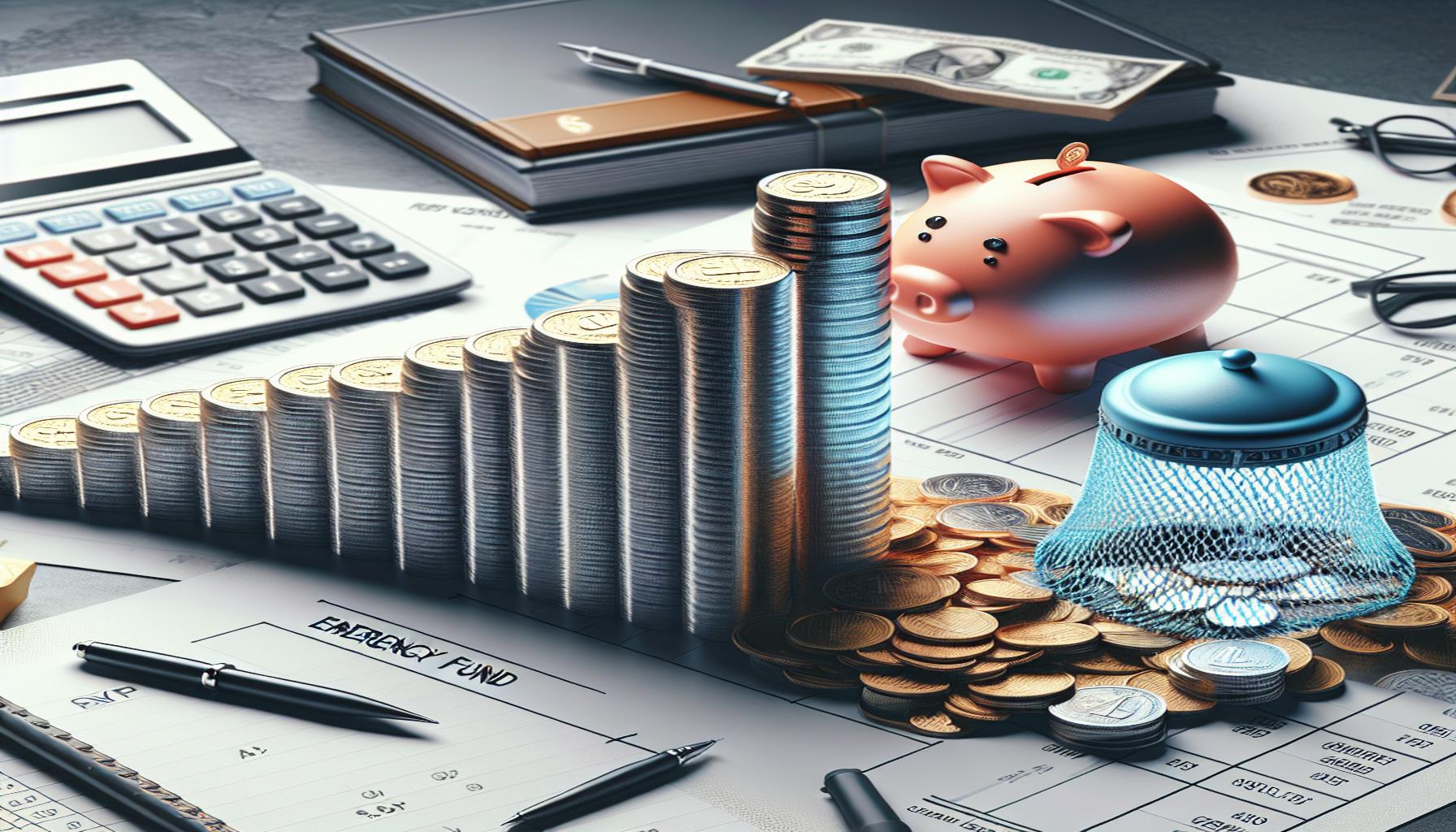Steps to Build a Solid Emergency Fund

The Necessity of Having an Emergency Fund
Life can throw unexpected challenges our way at any moment, such as sudden medical emergencies, job loss, or unforeseen vehicle repairs. This unpredictability underscores the crucial need for a financial cushion, often referred to as an emergency fund. Having access to funds when you need them the most can significantly contribute to your overall financial wellbeing. In Australia, where living costs can be significant, creating an emergency fund should be a vital component of every individual’s financial planning strategy.
How to Build Your Emergency Fund
Establishing an emergency fund may seem daunting at first, but breaking it down into manageable steps makes it significantly easier. Here are some important steps to consider:
- Determine Your Goal: A good rule of thumb is to aim for three to six months’ worth of living expenses. This means calculating your monthly costs, which should include essentials like rent or mortgage payments, utilities, groceries, and any necessary insurance. For instance, if your monthly expenses total $3,000, your emergency fund goal would be between $9,000 and $18,000. Having this financial buffer can help you navigate tough times without falling into debt.
- Choose the Right Account: Opt for a high-interest savings account to store your emergency fund. These accounts typically offer better interest rates than standard savings accounts, allowing your money to grow while remaining easily accessible. Be sure to look for accounts with no monthly fees or withdrawal limits to avoid penalties. In Australia, some online banks and credit unions may provide higher interest rates that are worth exploring.
- Automate Your Savings: One of the most effective ways to build your emergency fund is to automate your savings. By setting up automatic transfers from your primary bank account to your emergency fund account, you ensure that a portion of your income goes towards saving before you have a chance to spend it. This could be as simple as allocating $50 every week or $200 monthly, adjusting the amount based on your financial situation.
Implementing these strategies will help you foster your emergency fund and provide financial security when life’s unexpected events occur. In Australia, whether it’s an incredible medical bill from an unforeseen accident or urgent car repairs after a breakdown on the way to work, having this financial safety net not only protects your finances but also brings a sense of peace of mind. It allows you to face financial challenges confidently and stress-free.
In the following sections, we will delve deeper into practical tips and detailed steps to enhance your emergency fund-building journey. Together, let’s take this essential step towards a more secure financial future!
Practical Steps to Start Your Emergency Fund
Building a solid emergency fund requires commitment and a clear strategy. To make the process less intimidating, let’s break it down into digestible steps that you can act on immediately. The following strategies will guide you in creating a safety net that can provide peace of mind when life’s twists and turns occur.
Begin with a Budget
Before you begin saving, establishing a budget is essential. A budget helps you understand your financial landscape, determining how much you can realistically set aside each month for your emergency fund. Start by tracking your income and expenses over a month to identify discretionary spending and where cuts can be made. Key categories to consider include:
- Housing Costs: Rent or mortgage payments take up a significant portion of most people’s budgets.
- Utilities: Gas, electricity, water, and internet bills can vary, so keep a close eye on averages.
- Groceries: Assess your spending in this area, as meal planning can significantly reduce costs.
- Transportation: Include car payments, public transport costs, and fuel expenses.
- Discretionary Spending: Take note of dining out, entertainment, and hobbies that might be adjusted temporarily to boost your savings.
Once you have this budget in place, you can identify the area where you can squeeze out extra funds to allocate towards your emergency savings. For example, if you find you spend a significant amount on eating out, consider cooking at home more often, and redirect those savings into your emergency fund.
Set Realistic Savings Milestones
Rather than aiming to save your entire target amount in one go, it can be more motivating to set smaller, incremental milestones. Breaking down your larger goal into achievable benchmarks makes it feel less overwhelming. For instance, if your target is $12,000, consider establishing quarterly goals of $3,000. This way, you can celebrate small victories along the way, which will help maintain your momentum.
In addition to setting milestones, regularly reviewing your progress is crucial. Assessing your achievements quarterly or biannually enables you to stay engaged and make any necessary adjustments to your budget or savings plans. For instance, if you find you are consistently reaching your milestones early, consider increasing your contributions to expedite reaching your total fund goal.
Building an emergency fund is not just about saving money; it’s about instilling healthy financial habits that can propel you towards a secure future. With a dedicated budget and clear milestones in place, you’re setting yourself up for success on your journey to financial stability. This proactive approach fosters not only an emergency fund but also nurtures better financial management in other areas of your life.
As you continue down this path, remember that consistency is key. This journey takes time, but the reward of having a financial cushion to fall back on is well worth it.
Building Your Emergency Fund: The Next Steps
With your budget in place and realistic savings milestones established, the next steps involve choosing the right savings account and automating your contributions. These steps ensure that your savings are not only secure but also accumulate interest over time.
Select the Right Savings Vehicle
Choosing the right account to house your emergency fund is just as important as the amount you save. In Australia, options include traditional savings accounts, high-interest savings accounts (HISAs), and even online banks that often offer more appealing rates. Consider the following factors:
- Interest Rates: Look for accounts with the highest interest rates, as this will allow your savings to grow more efficiently over time.
- Accessibility: Ensure that the account allows easy access to funds in case of an emergency. You want to avoid accounts with excessive withdrawal limits or fees.
- No Monthly Fees: Seek accounts without ongoing fees, as they can eat into your savings.
- Withdrawal Limits: Some accounts may limit the number of withdrawals you can make each month. Opt for one that offers the flexibility you might need during emergencies.
Consider using comparison sites like Canstar or Finder to evaluate various accounts and find one that best meets your needs. This way, you are not only protecting your money but also allowing it to work harder for you through interest accrual.
Automate Your Savings
One of the most effective ways to build an emergency fund steadily is through automation. Set up an automatic transfer from your everyday account to your designated emergency savings account each payday. By doing this, you ensure that your savings grow consistently without needing to think about it. Here are some tips to set up automation effectively:
- Choose an Amount: Decide on a percentage of your income or a fixed dollar amount to transfer. Starting small is okay; even $50 a week can add up significantly over time.
- Make It Timely: Set the transfer date for just after you get paid, so the funds go into savings before you have a chance to spend them.
- Regular Review: Automating doesn’t mean you can forget about it entirely. Regularly review your budget and savings rate every few months to ensure it remains aligned with your goals.
By automating your savings, you’ll cultivate a habit of setting aside money for your emergency fund without the need for conscious effort. This strategy not only enhances your saving discipline but also alleviates the temptation to spend that money elsewhere.
Monitor and Adjust Your Fund
As life circumstances evolve, so should your emergency fund. Regularly assess your savings goal, especially if your expenses or lifestyle change. For instance, if you move to a new house or start a family, you may find that your emergency fund target needs to reflect those changes. Additionally, consider the inflation rate; the cost of living in Australia may affect how much you’ll eventually need.
Finally, as you gain confidence, consider expanding your financial knowledge. Engage with reputable financial literacy resources or workshops available online or in your community. Understanding your financial journey empowers you to make informed decisions and keep your emergency fund robust for whatever comes your way.
Conclusion
Building a solid emergency fund is an essential part of achieving financial security and peace of mind. By following the steps outlined throughout this article, you can establish a safety net that protects you against the unexpected challenges life may throw your way. Start by creating a budget that clearly identifies your needs and expenses, ensuring you set realistic savings milestones. This disciplined approach lays the foundation for effective saving.
Selecting the right savings account is crucial. Opt for options that offer high interest rates, easy accessibility, and no monthly fees to maximize your savings growth without incurring costs. Automating your savings can streamline the process, enabling you to set aside funds effortlessly each payday. This habit can significantly increase your savings without the temptation to spend those amounts instead.
Lastly, it’s important to regularly review and adjust your emergency fund based on changes in your lifestyle and expenses. Life evolves, and so should your financial strategies. By proactively monitoring your fund and participating in ongoing financial education, you can stay informed and confident in managing your finances.
In summary, establishing and maintaining an emergency fund is a practical and empowering measure. Not only does it provide a cushion for financial emergencies, but it also cultivates a sense of security and readiness for whatever lies ahead. Start today, and you’ll be taking a significant step toward achieving a more stable and resilient financial future.

Linda Carter is a writer and financial expert specializing in personal finance and financial planning. With extensive experience helping individuals achieve financial stability and make informed decisions, Linda shares her knowledge on the Take Care Garden platform. Her goal is to empower readers with practical advice and strategies for financial success.






